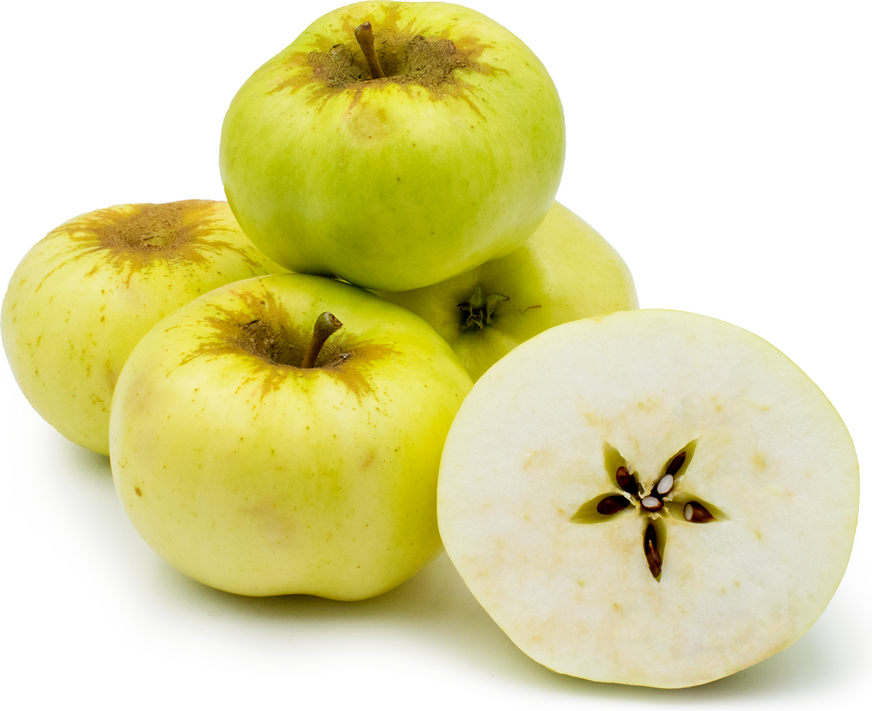


Hawthornden Apple
Estimated Inventory, lb : 0
Description/Taste
Hawthornden apples are a medium to large variety with a flat, slightly sunken shape. They typically measure about 5.5 centimeters tall and 7.5 centimeters wide and often feature a prominent rib on one side. They have a short, stout stem set within the apple's deep, russetted cavity. This varietal is primarily green-yellow in color flushed with faint pink-red splotches and stripes on the side exposed to the sun. Their thin skin is smooth, shiny, and firm, giving way to a creamy white-green flesh. The flesh is coarse and firm yet tender, easily melting away when cooked. Hawthornden apples are crisp and juicy. They have a predominantly tart taste, similar to most green apple varieties. The flavor's balance of sweetness and acidity tastes more rich when cooked.
Seasons/Availability
Hawthornden apples are available in the fall.
Current Facts
The botanical name for Hawthornden apples is Malus domestica and they are from the Rosaceae family. They are a Scottish heirloom apple sometimes referred to as White Hawthornden, Lincolnshire Pippin, Lord Kingston, Old Hawthornden, Wheeler’s Kernel, or White Apple. The variety is appreciated for both their ornamental and culinary qualities. Hawthornden apple trees are often planted in wildlife gardens or used as wall-side borders. In cooking, they are used as a baking apple that works well for making creamy sauces. Hawthornden apples need to be cross-pollinated with another apple tree to produce fruit. They must be paired with a variety that blooms flowers at the same time like the Golden Delicious, Gala, Granny Smith, or Fuji.
Nutritional Value
Hawthornden apples' nutritional value is not widely researched. Apples are generally known for being high in vitamin C, which can increase iron absorption, support immune function, encourage collagen production, prevent free radical damage, and improve bone and teeth health. The fiber in apples help maintain digestion, prevent overeating by increasing feelings of fullness, and stabilize blood sugar levels. They provide the body with potassium to help nerve signaling, muscle contractions, and blood pressure reduction. Potassium also aids in kidney stone, stroke, and osteoporosis prevention. Apples like the Hawthornen variety possess the antioxidants catechin, quercetin, and chlorogenic acid to help improve mitochondrial health, prevent viruses, and reduce blood sugar and inflammation.
Applications
Hawthornden apples are primarily used for cooking but can also be eaten fresh or dried. When fresh they are used as a topping for salads, fruit bowls, oatmeal, granola, pancakes, and waffles. This variety may be incorporated into baked goods like cakes, pies, cookies, tarts, cinnamon rolls, cheesecake, and muffins. They can also be made into a baked apple when paired with brown sugar and cinnamon. The flesh cooks down into a creamy puree that bodes well for making a rich applesauce. Hawthornden apples may be mixed into soup, stuffing, curry, apple cider, mulled wine, cocktails, and tea. They are complemented by foods like pork chops, cabbage, celery, kale, strawberries, bananas, oranges, pears, walnuts, almonds, goat cheese, cinnamon, vanilla, and caramel. Hawthornden apples will keep for one month in storage.
Ethnic/Cultural Info
The name of this apple alludes to the town in Scotland where they were first grown. Hawthornden, Scotland is also home to a 16th-century poet named William Drummond. He was one of the first Scottish poets to write in English rather than Gaelic. Scottish apple orchards were first established by religious orders in the twelfth century. Monks were brought in from Britain to exchange seeds and graft new gardens in even the most remote areas of Scotland, introducing horticulture practices that still persist in the country today. By the seventeenth century, orchards with apples, pears, and plums were a common feature of the estates in Southern Scotland while larger commercial production was centered in the urban areas of the Carse of Gowrie and Clydesdale. Over time, many Scottish heirloom apples have disappeared, prompting horticultural societies and experimental gardens to revive these historic varieties.
Geography/History
As its name suggests, the Hawthornden apple comes from a city of the same name near Edinburgh, Scotland. This variety originated sometime in the 1700s and was first recorded in the catalog of Leslie and Anderson. They were then brought to England and were commercially grown in Kent and London by the 1800s. Hawthornden apples declined in popularity in the 1890s because they were prone to bruising and could not be shipped easily. They require full sun and thrive best in the cold weather climates of the UK and Northern Europe. Outside of these regions, it’s unlikely to find Hawthornden apples though they may be purchased from seed and grown in home gardens with suitable climates.




